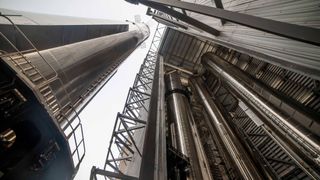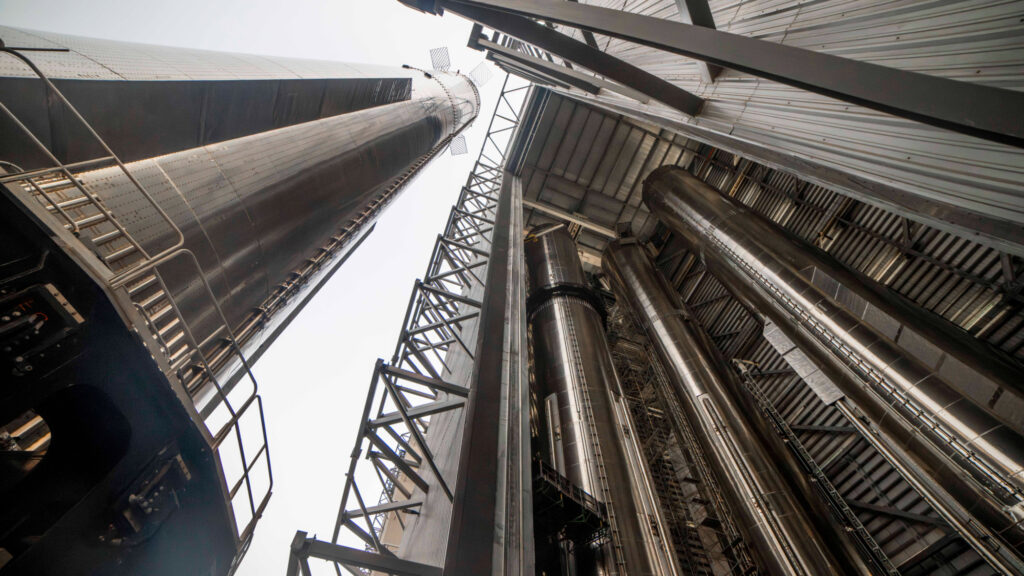
The Super Heavy booster for the fourth test flight of SpaceX’s Starship megarocket rolls toward the launch pad in this photo, which SpaceX shared via X on May 11, 2024.
(Image credit: SpaceX via X)
We’re likely still a month or so away from the next launch of SpaceX’s Starship megarocket.
That was the timeline Elon Musk offered in a post on X over the weekend, saying Starship’s next test flight is “probably 3 to 5 weeks” away. “Objective is for the ship to get past max heating, or at least further than last time,” the billionaire entrepreneur added.
The 400-foot-tall (122 meters) Starship is the biggest and most powerful rocket ever built. It consists of two elements, both of which are designed to be fully and rapidly reusable: a huge first-stage booster called Super Heavy and a 165-foot-tall (50 m) upper stage known as Starship, or simply “Ship.”
Related: Relive SpaceX Starship’s 3rd flight test in breathtaking photos
Multiple Starship vehicles are seen at SpaceX’s Starbase facility in South Texas in this photo, which Elon Musk shared via X on May 11, 2024. (Image credit: SpaceX via X)
A fully stacked Starship has flown three times to date, on each occasion from SpaceX’s Starbase site in South Texas — in April 2023, November 2023 and March 14 of this year. The giant vehicle has performed better with each successive flight.
During the debut liftoff, for example, Starship’s two stages failed to separate as planned, and SpaceX detonated the tumbling vehicle just four minutes after liftoff. Flight 2 achieved stage separation, but both Super Heavy and Ship broke apart early, ending the mission after eight minutes.
On Flight 3, Super Heavy successfully steered its way into position for a planned Gulf of Mexico splashdown but broke apart about 1,650 feet (500 m) above the waves. Ship reached orbital velocity and flew for nearly 50 minutes, though it ultimately succumbed to the violent forces of frictional heating when reentering Earth’s atmosphere.
Breaking space news, the latest updates on rocket launches, skywatching events and more!
As he noted in his X post, Musk wants Ship to do even better on the upcoming Flight 4.
SpaceX has been gearing up for Flight 4 for a while now. The company has already conducted static fire tests for both the Super Heavy and the Ship assigned to the mission, briefly igniting their Raptor engines while the vehicles remained anchored to the pad at Starbase. SpaceX also recently rolled Flight 4’s Super Heavy back to the pad, presumably for more testing, a move the company chronicled in a post on X on Saturday (May 11).
However, there may still be logistical hurdles to clear; SpaceX still needs to secure a launch license from the Federal Aviation Administration (FAA), which is overseeing an investigation into what happened on the March 14 flight.
Join our Space Forums to keep talking space on the latest missions, night sky and more! And if you have a news tip, correction or comment, let us know at: community@space.com.
Michael Wall is a Senior Space Writer with Space.com and joined the team in 2010. He primarily covers exoplanets, spaceflight and military space, but has been known to dabble in the space art beat. His book about the search for alien life, “Out There,” was published on Nov. 13, 2018. Before becoming a science writer, Michael worked as a herpetologist and wildlife biologist. He has a Ph.D. in evolutionary biology from the University of Sydney, Australia, a bachelor’s degree from the University of Arizona, and a graduate certificate in science writing from the University of California, Santa Cruz. To find out what his latest project is, you can follow Michael on Twitter.
>>> Read full article>>>
Copyright for syndicated content belongs to the linked Source : Space.com – https://www.space.com/spacex-starship-fourth-test-flight-june-2024-elon-musk
